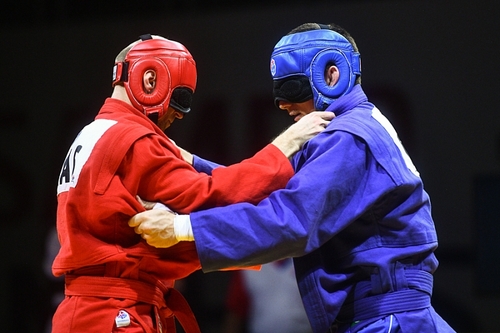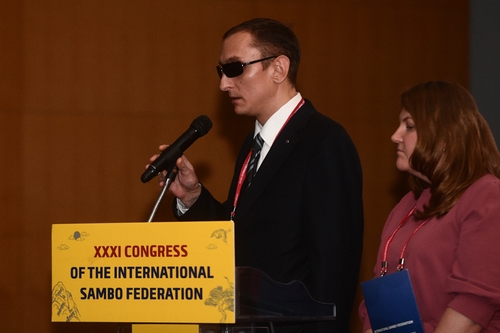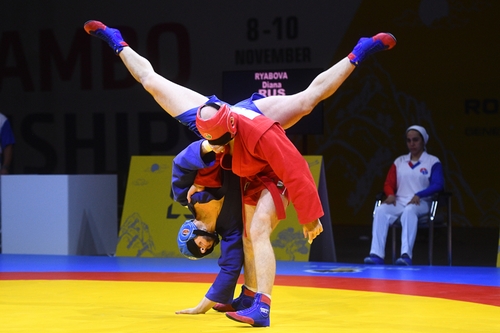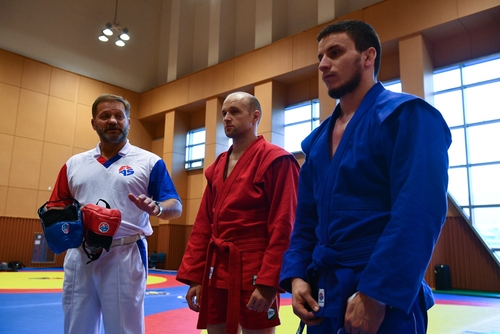
By the decision of the FIAS Executive Committee on October 4, the International SAMBO Rules for the Blind and Visually Impaired and the Classification Rules of SAMBO for the Blind and Visually Impaired were approved.
International SAMBO Rules for the Blind and Visually Impaired
Classification Rules of SAMBO for the Blind and Visually Impaired
Roman Novikov, member of the FIAS Commission for Athletes with Disabilities (Blind and Visually Impaired), called this event a historic one, noting the following:
“This is a turning point in the development of SAMBO for the Blind — new horizons are now open for athletes with visual impairments. The classification rules were developed based on the requirements of the International Paralympic Committee. SAMBO classification rules for the blind and visually impaired have been developed within the framework of the project of the SAMBO of the Blind Charitable Foundation ‘Overcoming’ — International Development of SAMBO for the Blind” by the project group and members of the FIAS Commission for Athletes with Disabilities".

As Novikov explained, the functional classification system used in the discipline of SAMBO for the Blind uses the characteristics and parameters of visual impairment and the scoring of the ability to maintain balance as the main principle of dividing into sports classes.
The assessment of the ability to maintain a stable balance is based on the fact that in order to achieve victory in SAMBO, the ability to maintain a stable balance is necessary, which is a condition for the effective execution of attacking and counterattacking actions.
Observation of the blind sambists during training and competitive fights showed that a blind athlete and a sambist with an insignificant visual impairment receive information about the behavior of their opponent mainly due to tactile sensations. To obtain more complete information, athletes try to get closer to the opponent, perform additional oscillatory movements to determine the opponent’s body movements and predict his subsequent actions, as well as determine their position relative to the opponent. However, such actions make the position of a sambist much less stable, which makes it easier to unbalance him and carry out a technique.

After loads on the vestibular apparatus, the stability of a blind athlete and a sambist with an insignificant visual remainder decreases significantly in comparison with sambists who use sight under similar conditions. The consequences of this were observed during competitive bouts, when, after the referee returned to the main stance “sleeve-lapel”, according to the rules, the technical actions of a blind sambist and an athlete with an insignificant visual impairment turned out to be much less effective than at the beginning of the match. This leads to a defeat in a bout when the opponent of such a sambist is an athlete with less significant visual impairment. Thus, in accordance with the functional capabilities, two sports classes of sambists were identified:
SVI1 — this group includes totally blind athletes and athletes with insignificant visual impairment wearing specialized helmets.
SVI2 — this group includes sambists with shaped vision, which makes it possible to distinguish objects at a sufficient distance and a positive influence of vision on maintaining balance.
The assessment of visual impairment is made in accordance with the results of an ophthalmological examination, the assessment is given by the parameters of vision in the better seeing eye with the best optical vision correction. Athletes with visual acuity over 0.1 of normal visual acuity, which is taken as 1.0 or 100% vision, and / or concentric narrowing of the visual field over 20 degrees, are not allowed to compete in Blind SAMBO.
To determine the ability to maintain a stable balance, the stabilometry method is used, as the simplest for an athlete, providing data that are quite simple for the classifier to interpret. Sambists are divided into 2 sports-functional classes (SAMBO Visual Impairment): SVI1 (0-3 points) and SVI2 (4-11 points) based on the results of the balance assessment on the stabiloplatform. The assessment is carried out without vision correction, namely in the conditions in which the athlete will compete.

The assessment takes into account that the presence of concomitant complications such as nystagmus, strabismus, defects in the visual field, a significant narrowing of the visual fields can significantly reduce functional capabilities and have a certain negative impact on its ability to maintain a stable balance.
A situation is possible when an athlete has some form of vision, but at the same time he, like a totally blind sambist, needs more time to achieve the best balance — visual impairments are such that the athlete cannot use it effectively, then such a sambist will be assigned the SVI class. 1. Based on the peculiarities of the scoring system, the opposite situation is theoretically possible — when an athlete with a lack of shaped vision has a significant positive effect of vision on maintaining balance. In this case, the Athlete will compete in the SVI-2 class under the supervision of the Classifiers. This will make the competitive conditions for sambists the most comfortable and fair.
Athletes of the SVI-1 class compete in special helmets. The purpose of the helmet is to protect the head and eye area of an athlete from injuries, who, due to lack of sufficient vision, is not able to timely dodge an accidental blow during a fight. And also to exclude the possibility of using an insignificant remainder of vision, which can disorient the athlete during a fight, for which an eye patch made of black fabric that does not transmit light is used in the helmet. The pad is equipped with a curtain that fits snugly to the nose and cheekbones. In this case, the penetration of light from the side of the lining to the area of the athlete’s cheekbones is possible and acceptable.
International SAMBO Rules for the Blind and Visually Impaired and Classification Rules of SAMBO for the Blind and Visually Impaired are published on the FIAS website — on the “Documents” page in the “Sports” section.

